How to use low gear field. Using a Chevrolet transfer case
Since the Chevrolet Niva is a priori an all-wheel drive vehicle, the transfer to all-wheel drive means the inclusion of a blocking of the interaxle (but not interwheel) differential of the transfer case. This is necessary in order to use all the wheels of the Chevy Niva in the event that one of them, say, hung on a lever above the pit. Unfortunately, this will not help if there is such a suspension of two wheels at the same time along the same side of the car or diagonally (this is called "diagonal suspension"). To prevent such troubles, some Niva owners (not only Chevrolet brands) put cross-axle differentials (self-blocks) with their own hands.
We help with all wheels
How to turn on all-wheel drive on a Chevrolet Niva? You can block the operation of the Chevy Niva center differential as standing car as well as during movement.
This is done with the clutch pedal depressed using the transfer case control lever, which is located behind the large gear selector. When the lever is in the neutral position, you need to pull it towards the driver. If you then press reverse side, a downshift will be engaged with a center differential lock and a gear ratio of 2.1. If you pull towards you, a downshift is activated (gear ratio 1.2).
At such positions of the lever, the corresponding yellow icon lights up on the dashboard. If these instructions fail, try repeating the procedure while driving.
 Refer to the owner's manual for that vehicle for the correct sequence for engaging the on-the-fly lock. It states that such blocking must be carried out in advance, while the car is moving on a section of paved road. The action is performed necessarily during a change in the position of the steering wheel. To prevent breakdowns and damage to the parts of the differential, blocking during slipping or slipping of the wheels (wheels) is prohibited. Mode switching is carried out using the same lever.
Refer to the owner's manual for that vehicle for the correct sequence for engaging the on-the-fly lock. It states that such blocking must be carried out in advance, while the car is moving on a section of paved road. The action is performed necessarily during a change in the position of the steering wheel. To prevent breakdowns and damage to the parts of the differential, blocking during slipping or slipping of the wheels (wheels) is prohibited. Mode switching is carried out using the same lever.
In the event that the lock does not turn on in this way, do not apply excessive force. Just repeat the entire sequence of actions from the beginning.
Downshifting is also permitted without completely stopping the Niva, but this can only be done by experienced drivers. The fact is that in the transfer case, unlike the gearbox, synchronizers are not installed. Downshifting to upshift while the vehicle is moving is undesirable, although it is allowed in extreme cases.
It is not recommended to constantly keep the locked mode of operation of the center differential of the wheels, especially when driving on paved roads, as this will lead not only to an increase in fuel consumption of the car and poor control of it, but also to the breakdown of expensive transmission units.
On all cars from the SUV family, there is one feature by which these cars are able to overcome any road surface, even if there is no such surface. This feature is the presence all-wheel drive all four wheels with differentials.
The differential has the form of a mechanical installation with a set of planetary gears and shafts. It is designed to distribute torque from the Chevrolet Niva engine to the drive wheels, which are mounted on the same axle. This makes it possible to spin the wheels of the car with different speed. Spinning the wheels at different speeds is very important when cornering a car when one wheel has a small radius and the other has a large radius. In the absence of an interwheel differential, this would lead to a spinning (slip) of the wheel, which passes a smaller radius. A slip of one wheel would cause the vehicle to skid and increase tire wear.
When the car is moving in a straight line at a constant speed, then the thrust from the engine to the wheels is evenly distributed. This encourages both drive wheels to rotate at the same speed. When one of the drive wheels slips, the differential automatically distributes the traction force from the engine. At the same time, the force on the slipping wheel increases and decreases on the standing one.
Usually cars have only one differential installed in the drive axle. There are three of them on Chevik:
- Two differentials are installed in the front and rear axles of the car, which make it possible for the drive wheels to rotate on the same axle at different speeds.
- The third one is central (interaxal action). It contributes to the distribution of torque from the engine to both axles of the vehicle.

Chevrolet Niva differential lock
Off-road vehicles, including the Niva, have the ability to turn on the lock of all three (cross-wheel locks - optionally installed) differentials. Thus, the cross-country ability of the car in severe off-road conditions is increased many times over.
During the slipping of one wheel of the car, through the differentials, the traction force will be transmitted from the engine to this wheel. All other wheels will be at rest, since the traction force will not act on them. Thus, the car will be in an immobilized state. For example, while slipping in a pit with one wheel, the remaining wheels will be at rest. This means that all the traction force will be transferred to the slipping wheel and will contribute to its rotation.
The purpose of the forced differential lock is to combine the drive wheels with each other, while ensuring their rotation at the same speed. Blocking makes it possible to use the traction force transmitted from the car engine to the maximum.
The principle of operation of the differential lock on the Chevrolet Niva. As you know, the differential consists of gears and shafts, which make it possible to automatically distribute torque from the engine to the wheels. Forced differential lock does not allow the gears to rotate, which is achieved using a special locking clutch. Thus, when manually engaging the lock, the driving wheels of the car are rigidly connected to each other. This connection makes it possible to rotate the wheels with the same speed. When the center differential lock is engaged, the drive shafts of the front and rear wheels are rigidly connected to each other, thereby providing a uniform torque to the front and rear wheels. rear axle. The cross-country ability of the car is increasing, which makes it possible to be the first SUV of its kind. When the grip of the car's wheels is better, the more traction power the car will receive.

When to Use Differential Lock
Not all cars have the ability to lock the differential, which makes these cars more vulnerable off-road. And sometimes it happens that now two bridges would be useful on a car. Chevrolet Niva is a unique car that has great cross-country ability on all types of off-road and even mountainous surfaces.
Forced blocking is used in the following cases:
- During the overcoming of road sections with increased difficulty by the car. The blocking is activated prematurely, before entering such a road.
- On steep slopes or mountainous terrain where there is a possibility of wheel slip.
- When driving on a dry sandy road.
- When the road is covered with an ice layer or snow crust.
When to Disengage the Differential Lock
During normal driving on a Chevrolet Niva car on ordinary asphalt roads, the use of a differential lock is not required. The wheels on the road with a normal surface have good grip, and therefore have a uniform torque. Therefore, when driving on roads that are good traction material for the wheels, the use of a lock is not required.
A few rules for using the differential lock:
- Switching the transfer case to lower gears must be carried out only when the car is stopped.
- Engaging the differential lock is permitted while driving without stopping.
- Downshifting is permitted without stopping the vehicle.
- To ensure the normal operation of the differential lock, it is necessary to periodically switch the differential lever on the transfer case. It is recommended to carry out such an action once a week, and especially in winter time.
Where does the forced differential lock turn on in the Chevrolet Niva
In the cabin, between the driver and passenger seats, there are two control levers. One of them is the gear lever (gearbox). The other is the control lever of the car's razdatka. The main component of the differential lock is the transfer case, which is a two-stage gearbox. The control lever is brought out of this gearbox into the cabin. Its movement back and forth serves to turn on and off a low gear from the gearbox to the vehicle's drive axles. And the movement to the right and left is designed to engage the differential lock. This lever has a short handle. If you switch the lever to the left position, then this means that the lock is on, if you move the lever to the right position, then the lock is off.
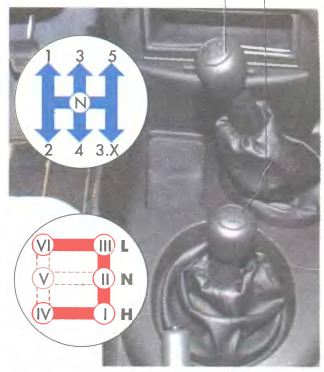
shift diagram of the gearbox and transfer case Niva Chevrolet
What does a downshift
The reduction gear, which is one of the components of the transfer case, has a two-stage gearbox. Switching steps is made by the same lever that serves to lock the differential. When switching this lever to the rear position, the transfer ratio of the transfer case is low, and equal to 1.2. With the lever position forward, the gear ratio will double (downshift), and will be 2.1. In the middle position (neutral) the gear ratio is zero. That is, the gearbox in the transfer case is open and does not transmit traction forces.
The differential lock is an integral part of the vehicle's all-wheel drive mechanism. Using the lock turns the car into effective remedy driving in harsh off-road conditions.
Do you still think that car diagnostics is difficult?
If you are reading these lines, then you have an interest in doing something yourself in the car and really save because you already know that:
- Service stations break a lot of money for simple computer diagnostics
- To find out the mistake you need to go to specialists
- Simple wrenches work in the services, but you can’t find a good specialist
And of course you are tired of throwing money down the drain, and it’s out of the question to ride around the service station all the time, then you need a simple ELM327 AUTO SCANNER that connects to any car and through a regular smartphone you will always find a problem, pay off the CHECK and save a lot! !!
Is your Shniva reliable?
Niva is a car that has been produced since 1977. It differs from other domestic cars with permanent all-wheel drive. Few motorists know what this means, although they have heard about this feature of the vehicle, the device diagram can be easily found on the Internet. Four-wheel drive in the Niva is equipped for all 4 wheels, and the center differential is locked. The mechanism consists of a gearbox, a transfer case designed for 2 steps, and cardan shafts located in the front and rear of the machine. This also includes the front and rear axles.
When the engine starts to rotate, the impulse goes to the gearbox and transfer case, after which the torque is distributed to the front and rear axles at the same time. After that, the gearboxes are put into action, behind them the front and rear wheels Niva. The torque makes 4 wheels rotate at once, so it is called full. But the rear wheels are still leading.
Why Niva needs blocking
The wheel differential is a mechanism that provides the car with wheels rotating at different speeds, while not switching gears, but changing when cornering, when one wheel describes a small diameter, and the other a large circle. In the absence of a differential, the wheels in the Niva would begin to slip, which is fraught with damage and rapid abrasion of the rubber.
When the vehicle is moving on a flat roadway, the traction from the motor falls on 4 wheels evenly.
When slipping at least one wheel, which is often found on an icy track, the differential exerts more effort on the slipping wheel. In other cars, such a device involves installation on a leading type bridge. At Niva, it is located in other areas:
- on the rear and front axles;
- in the center between the axles, located near the gearbox and axles.
How to turn on the differential lock on the Niva
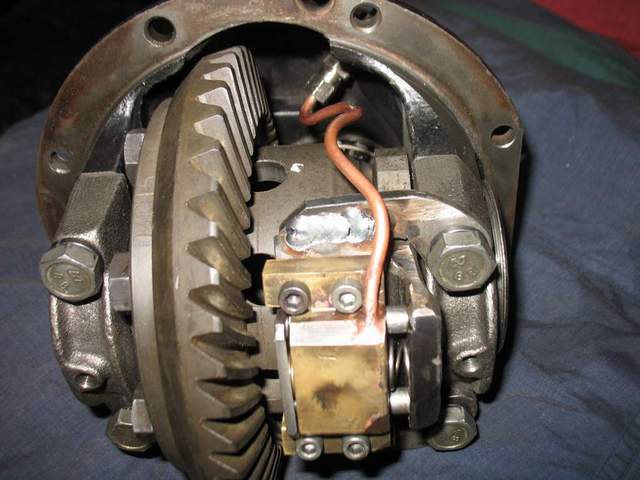 Niva and its various modifications allow you to activate 3 differentials at once. Due to this factor, the cross-country ability of the vehicle increases several times when the car is moving in rural areas. The forced lock format includes the combination of the drive-type wheels, which is why they spin at different speeds. This approach allows you to use the maximum possible traction characteristics of the engine, which are transmitted to the wheels.
Niva and its various modifications allow you to activate 3 differentials at once. Due to this factor, the cross-country ability of the vehicle increases several times when the car is moving in rural areas. The forced lock format includes the combination of the drive-type wheels, which is why they spin at different speeds. This approach allows you to use the maximum possible traction characteristics of the engine, which are transmitted to the wheels.
To implement the differential lock on the Niva, the manufacturer provided a clutch for the blocker. When the forced lock is turned on, the wheels become interconnected and rotate in the same mode. When the interaxle blocker is turned on, the axles located in front and behind interact and distribute traction to all wheels. Such a mechanism is convenient to use, which confirms the unique cross-country ability of the Chevrolet Niva.
When to apply and how to disable blocking
Forced blocking in various Niva modifications is preferably enabled in such situations:
- The lock must be turned on in advance if a difficult route is to be overcome.
- On sharp uphill or downhill slopes.
- While crossing the area with top layer sand.
- When you have to drive on snow drifts or an icy track.
Wheel locking is not needed during a quiet ride on flat road in the city. Asphalt grip will be decent, traction distributed evenly by default.
Rules for applying blocking on the Niva
For the locking mechanism to work long time use these rules:
- It is necessary to switch the transfer case when the Niva is not moving.
- You can also turn on the differential while the vehicle is moving.
- To ensure efficient and long-term operation of the device, it is advisable for the Niva driver to turn on the lock from time to time. Once a week in winter is enough.
Where is the shift lever located? Pay attention to the area between the wings, located in front, there are 2 levers. One makes it possible to shift gears at the checkpoint, the other successfully controls the transfer case.
The basis of the transfer case is a gearbox, which includes 2 steps. The control lever comes just from it, you can move it back and forth - this is how the gear is changed on the Niva. The direction of movement of the lever to the left and right allows you to activate the differential lock and vice versa to turn it off.
Why do you need a downshift
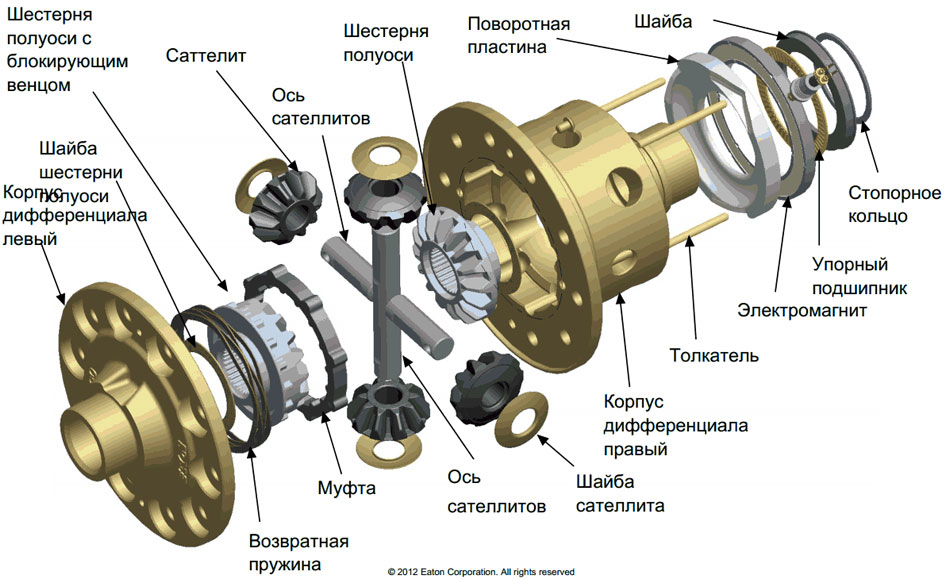 It is difficult to imagine a razdatka without the main functional component - a reduction gear. The presence of the lever in the rear direction reduces the value of the transfer case to 1.2.
It is difficult to imagine a razdatka without the main functional component - a reduction gear. The presence of the lever in the rear direction reduces the value of the transfer case to 1.2.
By fixing the lever in front, the gear ratio can be increased to a value of 2.1. The lever in neutral indicates gear ratio 0.
To use the lock installed on the Niva effectively, use the following recommendations from experts:
- Driving on pavement good quality, install the front handle of the transfer case in front and the rear handle in the back.
- The front handle is moved back if the road is replaced by a slippery surface. After the slippery area managed to pass, switch the levers to normal mode.
- If the Niva is stopped, the lock may not engage when the clutch is depressed. This is due to the alignment of the teeth with the gear teeth. What should be done in this case? Moving as if on a bend, connect the lock. The differential will turn and the gear cavities will come closer to the teeth. If switching off is difficult, do this while the vehicle is moving, keeping the minimum speed and depressing the clutch.
How the cross-axle differential lock on the Niva works is clearly shown in the video:
All SUVs differ from ordinary cars in that such cars can overcome any obstacle on the road, even when the road is completely absent. These cars received this feature due to the presence of all-wheel drive in them, which can be either permanent or plug-in.
Four-wheel drive is driven by differentials. This is also the Niva Chevrolet.
This mechanism contains shafts and gears. The differential is designed to distribute torque from the engine to the wheels. In the Niva, the main driving wheels are the rear ones. With the help of a differential, the wheels can spin at different speeds., for example, when cornering. In this case, one wheel passes a small radius, and the other - a large one. If there were no differential, then the wheels would begin to slip, which would cause increased tire wear.
Lever Location
When driving on a straight road, the thrust from the motor is distributed evenly between the wheels. If one wheel begins to slip, for example, on ice, then the differential transfers more force from the engine to it. Such a mechanism is mainly installed on the drive axle. At Niva, he stands on:
- rear and front axle.
- Between axles (central). Located between the gearbox and axles.
Video on how the cross-axle differential lock works on the Niva Chevrolet
Differential lock engagement
Chevrolet Niva has an opportunity turn on all three differentials at the same time. Thanks to this, the cross-country ability of the car increases several times when driving off-road.
Forced locking is that the drive wheels are combined with each other, as a result of which they can rotate at the same speed. Thanks to the blocking, the traction force of the engine will be used to the maximum, and transferred to the wheels.
As already mentioned, the differential assembly consists of shafts and gears. With the help of them, the traction force is automatically distributed between the drive wheels. Differential locking is carried out using a blocker (clutch). In this case, when the driver turns on the forced lock, the wheels "become" interconnected. This ensures that they will rotate evenly.

Differential assembly
If the interaxle lock is forcibly turned on, then the front ones and are also rigidly connected at once, which guarantees an even distribution of traction to all four wheels. Thus, the cross-country ability of the car will be increased several times, which makes the Chevrolet Niva a real SUV.
Applying a lock
Not all cars are equipped with blockers, and therefore they will be vulnerable off-road. Chevrolet in this regard is a unique car that can move both with one drive and with full, which allows him to feel confident even on mountain roads.
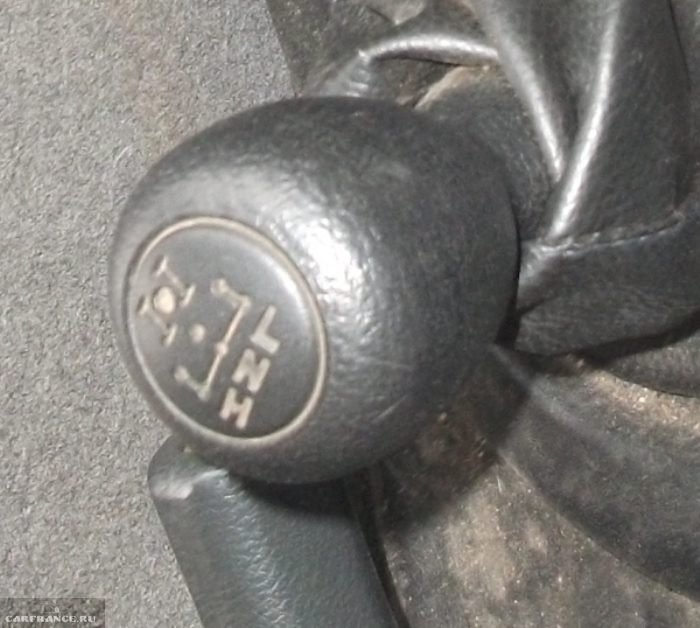
To engage the differential lock, pull the lever all the way to the left.
Forced blocking should be enabled in the following cases:
- When overcoming difficult sections of the route. In this case, the blocking should be turned on in advance, even before leaving for such a site.
- On steep inclines or slopes where wheel spin is possible.
- When driving on sand.
- When driving on snow or ice.
Disabling the lock
When Niva moves on a normal road with a smooth surface, she will not need to turn on the blocking of all wheels. They will normally adhere to the coating and not slip, since the traction force from the engine will be distributed evenly on them. For this reason, when the car is moving on a good road, where the wheels will not spin, the use of a differential will not be required.
Differential Rules
These include:
- Switching the transfer case should be carried out only when the car is not moving.
- You can also engage the differential while driving.
- You can downshift while the car is moving.
- To ensure continuous and trouble-free operation of the differential, it is necessary to turn it on periodically, especially in winter. This should be done every 7 days.
Shift Lever Locations
Inside Niva Chevrolet there are two levers between the front seats. With the help of one of them, you can shift gears in the gearbox, and with the help of the other, you can control the transfer case.

Differential shift lever
The transfer case is based on a two-stage gearbox. From it, the control lever enters the salon. He can move forward or backward. At the same time, it turns on / off the downshift. If the lever is moved to the left or right, it can engage/disengage the differential lock.

The scheme of gear shifting and handouts
Downshift: what does it give?
The main component of the dispenser is a reduction gear. If the control lever is in the rear position, then the number of razdatki decreases and is 1.2 . When the lever is in the forward position, the gear ratio increases. It will already be 2.1 . When the lever is in neutral position, the gear ratio is 0 .
The differential is an integral part of the all-wheel drive mechanism in any car. It is recommended to use it only when the car is moving off-road.
Video about the operation of the gearbox and the rules for using the Chevrolet Niva differential
Alas, not everyone knows how to use the transfer case on the Chevrolet Niva. Before starting the analysis of this topic, it should be noted that this car is an excellent option not only for adrenaline lovers, but also for people who use the vehicle specifically for driving in urban areas. Everyone knows that there is a transfer case here. It is good because it allows you to perform several important operations with one movement of the lever. To use a lower gear, the lever is moved to the right side, and then goes up. It is logical that for an increased one, it is only retracted. Many will be surprised, but using the transfer case, you can turn on the neutral. This is a good opportunity to keep the vehicle in one place. The lock is easily engaged in both high and low gears. You just need to move the lever to the left.
Downshifting - how is it done?
How to use a transfer case on a Chevrolet Niva? What's the point of engaging the lock and downshift? The questions seem simple, but quite serious. However, everything is very simple. It is enough to imagine driving on the road at the fifth speed. Everything is fine, including the quality of the road surface, but suddenly a huge puddle appears in front of the driver. It is clear that if the car gets into it, it will simply sink. To avoid this, you need to stop and shift from high to low gear. Yes, you really need to slow down completely.
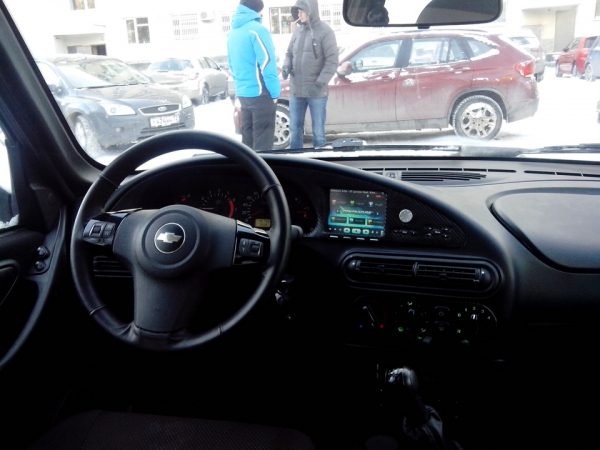
The point is the presence of a differential located between the two axles. Its presence will not make it possible to immediately switch from high to low gear and, accordingly, back. So what's the point of having a low gear?
Again, you should imagine a situation where you need to overcome a too dirty section of the road. The car is moving in third gear. The driver understands that the vehicle hardly overcomes such obstacles. It's time to switch to the first speed, but this does not give the desired effect. Actually, in such a situation, a lower gear will come in handy.
talking plain language- this is a small half of the usual first. You can guess that the second reduced is a simple first. It is generally accepted that a low gear is ideal for driving on a bad road. Turning it on, do not sharply press on the accelerator pedal, because at this very moment the wheels will be too loaded, and this will lead to the formation of a hole. Naturally, further movement will be impossible. In such a situation, the car gives the driver a chance to feel as accurately as possible how the wheels rotate. If suddenly they begin to sink into the ground, this can be understood by their uneven movement. Now the main thing is to notice in a timely manner that problems have appeared, while there is an opportunity to correct the situation. Alternatively, you can try to change the direction of movement.
If the vehicle is driven through puddles or muddy ground, never downshift to second gear. Increasing the torque, the car can simply "choke". Simply put, it will be difficult to drive and this will lead to the fact that the engine will stop working at the most crucial moment.
The driver can move in the third reduced gear. If there is a feeling that it is difficult for the car to cope with the load, then it is better to switch to a simple first or second, which will also prevent stalling, as in the previous case.
What is blocking for?
The all-wheel drive machine is designed specifically to overcome the most difficult obstacles. The described iron horse is an ideal SUV. The available blocking allows you to make the machine as powerful as possible. At the moment when the lock is turned on, those wheels are included in the work, which is easier to do.
Including blocking, most often, two bridges begin to function at half of their maximum capabilities. In fact, one wheel is spinning on the front axle and on the rear axle.
The issue under discussion is relevant in the case when the vehicle starts to slip directly at the moment when the lock is turned off. In such a situation, it is the stuck wheels that are slipping. Alas, they begin to sink even further into the ground. As soon as the blocking begins to function, the wheels that are not stuck are put into operation and thus pull the car out of the mud.
After reading this article, it becomes clear why you need a transfer case. In some situations, without it, it will really be tight. I would like to believe that now everyone knows and understands how to use the transfer case on the Niva Chevrolet. There is absolutely nothing complicated in this, but in order to avoid difficulties, it is worth reading this material as carefully as possible.




